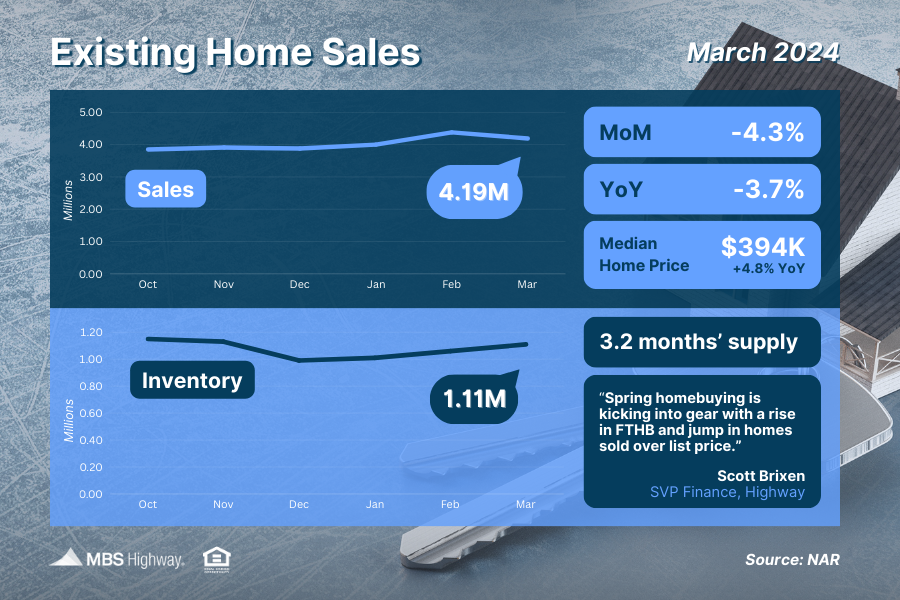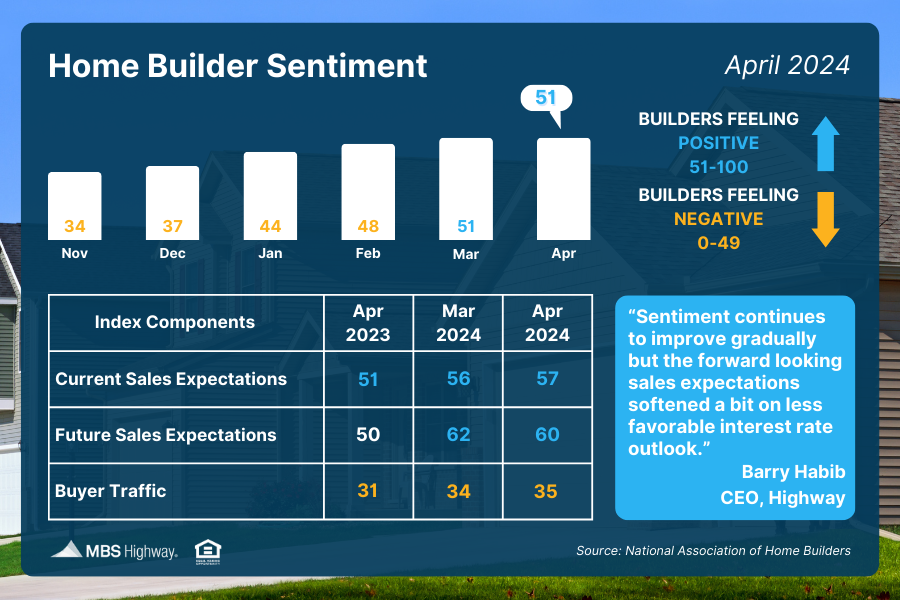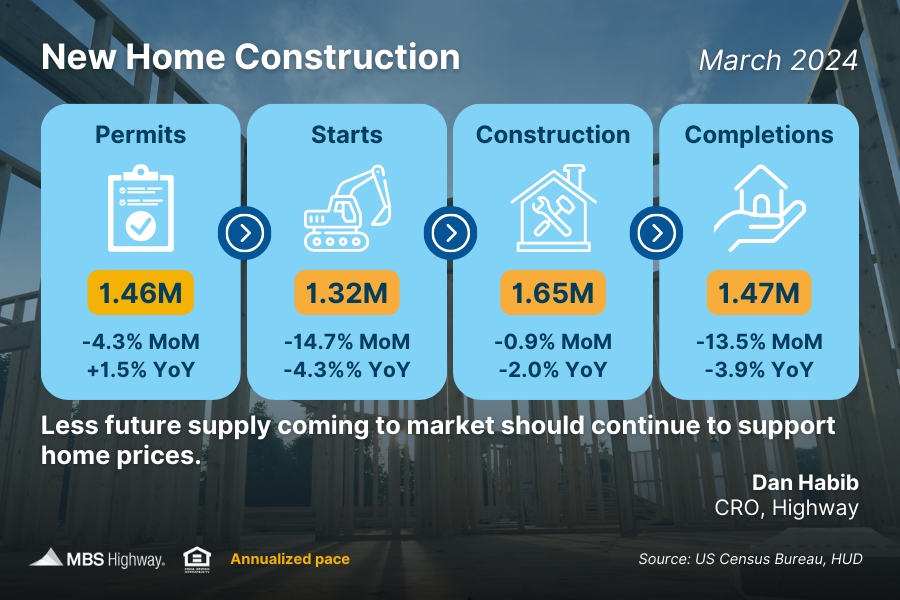Newsletter – 4/22/2024
Week of April 15, 2024 in Review
Existing Home Sales Slip

After hitting their highest level in a year in February, Existing Home Sales fell 4.3% in
March to a 4.19-million-unit annualized pace, per the National Association of
REALTORS (NAR). This report measures closings on existing homes in March and
likely reflects people shopping for homes in January and also in February when rates
began to tick higher.
What’s the bottom line? While the pace of sales declined in March, it remains at the
second highest level since last May, with NAR’s Chief Economist, Lawrence Yun,
confirming that sales have rebounded from cyclical lows.
In addition, some of the internals within the report showed signs of strength. Homes
remained on the market for a shorter period (an average of 33 days in March down from
38 days in February), while a greater number of homes sold above list price (29% in
March versus 20% in February). This signals demand and competition remains ahead
of the spring buying season.
Plus, there was some good news on the inventory front, as there were 1.11 million
homes available for sale at the end of March, up 4.7% from February and 14.4% from a
year earlier. While this remains below healthy levels, rising inventory is certainly a step
in the right direction to help improve the persistent tight housing supply we’ve seen
across the country. Yun added that “more inventory is always welcomed in the current
environment.”
Home Builder Sentiment Holds Steady

Confidence among home builders remained just above the key breakeven threshold of
50 for the second straight month, per the National Association of Home Builders
(NAHB), as their Housing Market Index stayed at 51 in April. Any score over 50 on this
index, which runs from 0 to 100, signals that more builders view conditions as good than
poor.
Among the three index components, current and future sales expectations both remain
in expansion territory at 57 and 60, respectively, though future expectations have
softened as some buyers remain on the fence. The gauge judging buyer traffic moved
higher, but it’s still in contraction territory.
softened as some buyers remain on the fence. The gauge judging buyer traffic moved
higher, but it’s still in contraction territory.
What’s the bottom line? NAHB’s Chief Economist, Robert Dietz, explained, “April’s flat
reading suggests potential for demand growth is there, but buyers are hesitating until
they can better gauge where interest rates are headed.”
Housing Starts Slide in March

Even though home builder sentiment held steady, builders pulled back on new
construction last month, with Housing Starts falling nearly 15% from February. Starts for
single-family homes, which make up the bulk of homebuilding and are the most crucial
due to buyer demand, were also down 12.4%. There was a similar trend in future
construction, with Building Permits moving lower despite much needed supply.
What’s the bottom line? The NAHB noted that higher than expected interest rates,
hotter than anticipated inflation, and higher supply side costs all contributed to the
construction slowdown last month. Danushka Nanayakkara-Skillington, NAHB’s
Assistant VP for Forecasting and Analysis, added that single-family construction will
also likely decline in April, given the drop in building permits last month.
Home prices should remain supported, as there still is not enough supply coming on the
market to meet demand, showing that opportunities remain to build wealth through
homeownership.
Rates Higher for Longer
While speaking to a policy forum on U.S.-Canada economic relations, Fed Chair
Jerome Powell said that recent data has “clearly not given us greater confidence” that
inflation is moving toward the Fed’s 2% target. This includes hotter than expected
consumer inflation readings in recent months, especially as measured by the Consumer
Price Index.
Remember, the Fed aggressively hiked their benchmark Fed Funds Rate (the overnight
borrowing rate for banks) eleven times between March 2022 and July 2023 to slow the
economy and curb runaway inflation. The Fed has held rates steady as of their meeting
last September because inflation had been showing good progress lower before stalling
in more recent reports.
What’s the bottom line? Powell said it will likely take longer to achieve confidence that
inflation is progressing lower, signaling that the timing for rate cuts will probably be
delayed and rates will be higher for longer until confidence is restored. This more
hawkish tone was echoed by other Fed members last week as well, including New York
Fed President John Williams and Atlanta Fed President Raphael Bostic.
Continuing Unemployment Claims Remain Above 1.8 Million
Initial Jobless Claims were flat in the latest week, as another 212,000 people filed for
unemployment benefits for the first time. However, Continuing Claims rose by 2,000,
with 1.812 million people still receiving benefits after filing their initial claim.
What’s the bottom line? Initial Jobless Claims can be volatile from week to week, but
their relatively low level suggests that employers are still trying to hold on to their
workers. Yet, Continuing Claims are still trending higher near some of the hottest levels
we’ve seen in recent years, as it’s become harder for some people to find new
employment once they are let go.
with 1.812 million people still receiving benefits after filing their initial claim.
What’s the bottom line? Initial Jobless Claims can be volatile from week to week, but
their relatively low level suggests that employers are still trying to hold on to their
workers. Yet, Continuing Claims are still trending higher near some of the hottest levels
we’ve seen in recent years, as it’s become harder for some people to find new
employment once they are let go.
What to Look for This Week
We’ll get an update on signed contracts when March’s New and Pending Home Sales
are reported on Tuesday and Thursday, respectively. Thursday also brings the latest
Jobless Claims and the first reading on GDP for the first quarter. A crucial inflation
reading ends the week on Friday with the Fed’s favored measure, Personal
Consumption Expenditures.
Technical Picture
Mortgage Bonds appear to have stabilized in the middle of a wide range with support at
98.867 and resistance at 99.647. The 10-year is also trading in a wide range between
support at 4.459% and a ceiling at 4.694%, which is the high for this year.



